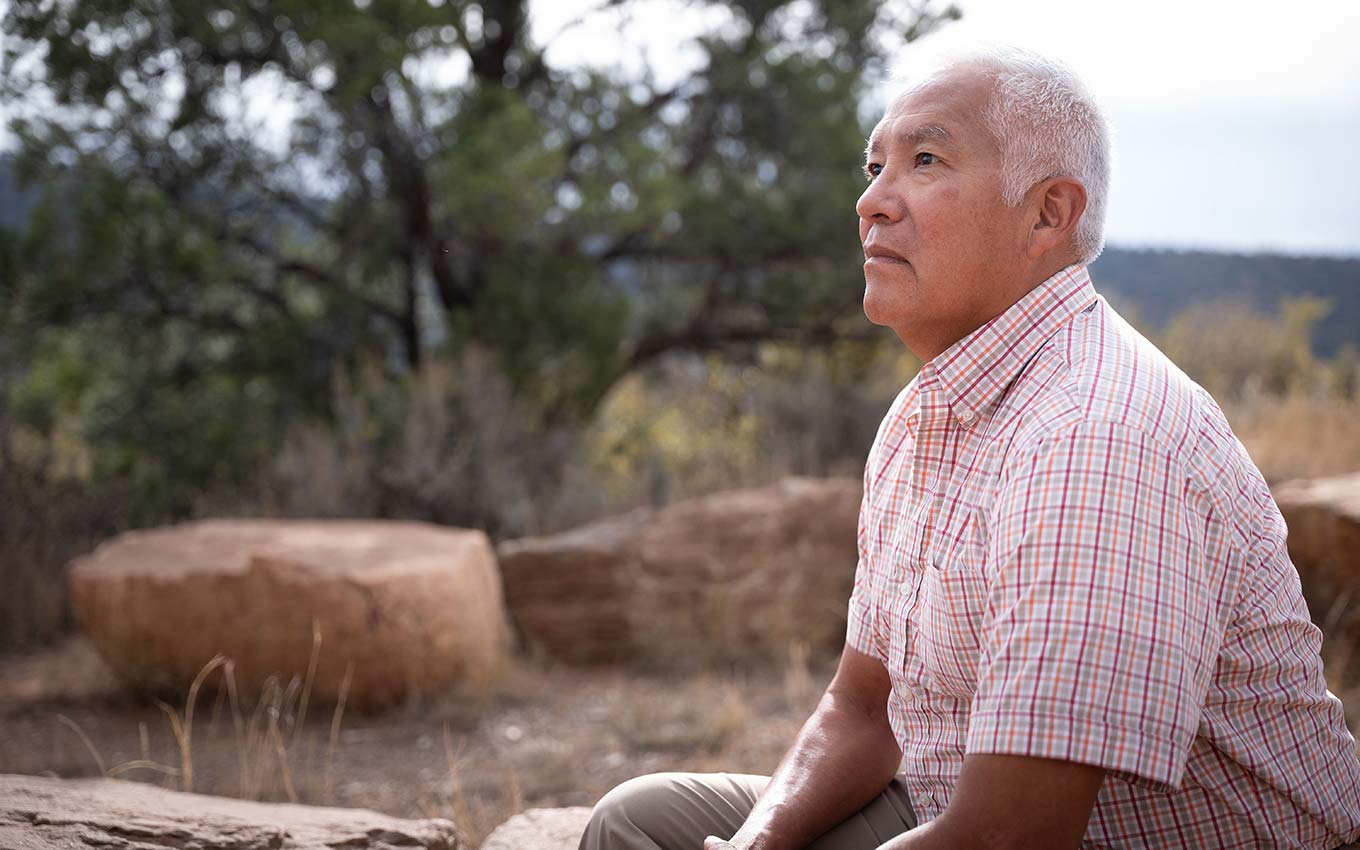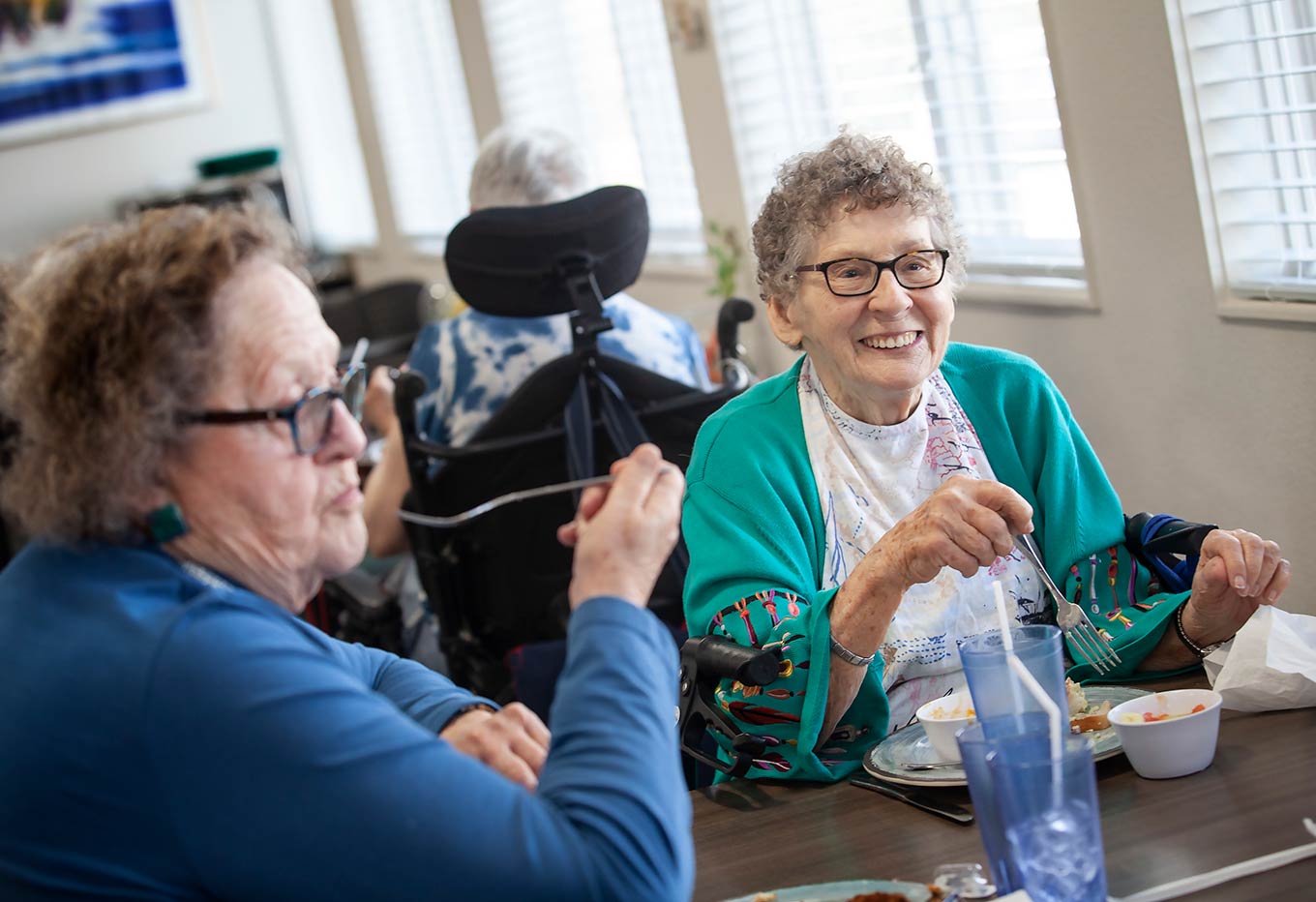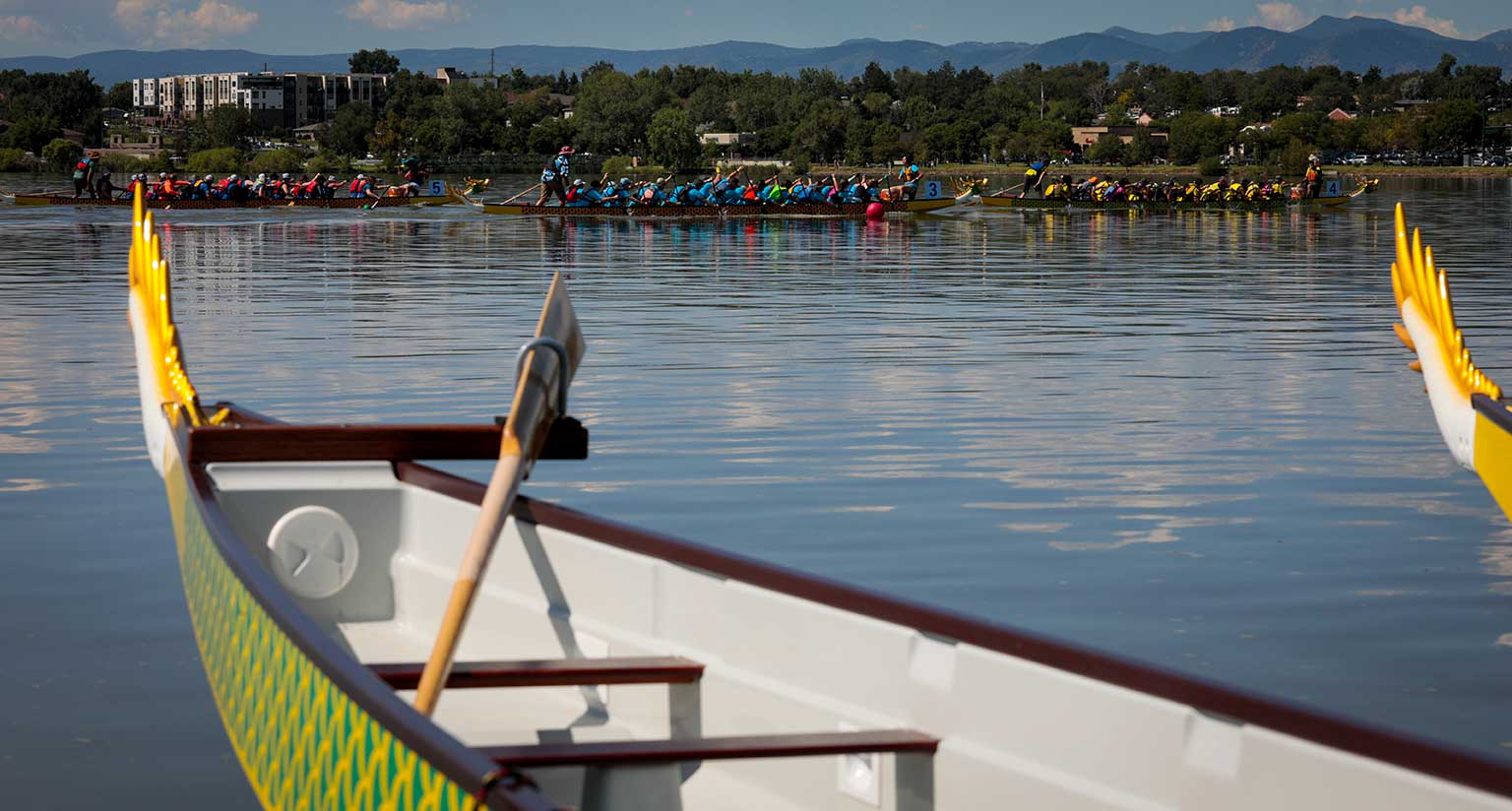Raymond Baker, a member of the Southern Ute Indian Tribe, was hired in 2020 by the Colorado Secretary of State’s office to be the state’s first tribal registration and voting education coordinator. It was a temporary role that started just a couple of weeks before the election.
Baker knew how difficult it was to get information to this community because of its rural location, so he was excited to help distribute up-to-date, nonpartisan voting information to the two federally recognized tribal nations in Colorado, the Southern Ute and the Ute Mountain Ute. (Both are Colorado Trust grantees.)
“That constant feed of information is lacking,” Baker said. “The awareness is very strong-willed in me to make sure we get the right information out there in a timely manner, which we seem to fail at really well.”
Baker, 59, wasn’t new to volunteer positions. The retiree spends much of his time working with the Boys & Girls Club of the Southern Ute Indian Tribe and the Adaptive Sports Association, among other organizations. But this statewide work felt especially valuable.
“I think voting is very important,” said Baker, who served in the U.S. Navy for 30 years. “It’s our responsibility to give [people] the best information we have so that they can make the best choice on who they want to be their representative, be it for the state, the county or for America.”
Like many rural communities, the Southern Ute Indian Tribe often struggles to get that information due partly to geography, socioeconomic conditions and access to technology. According to the Colorado Health Institute (also a Colorado Trust grantee), 12% of homes in the southwest corner of the state—which includes La Plata County, where most of the Southern Ute reservation is—lack broadband access.
Mail can also experience significant delays. Paper copies of The Southern Ute Drum, the tribe’s biweekly newspaper, sometimes reach subscribers up to a week after publication. The snail’s pace of the delivery is a running joke in the community. (To counter the delays, the newspaper publishes free e-editions on its website.) Another complicating factor is the proximity of Ignacio (where the tribe’s headquarters are located) to New Mexico, which means the area’s broadcast TV news comes almost entirely from Albuquerque.
“We don’t get any Colorado news,” said La Plata County Clerk and Recorder Tiffany Lee, who relies more on radio and the county website to share information. “Not having Denver TV makes a difference. …That’s a challenge.” She regularly has county residents question why a particular candidate is not on a ballot and has to explain that the person is running for office in New Mexico.
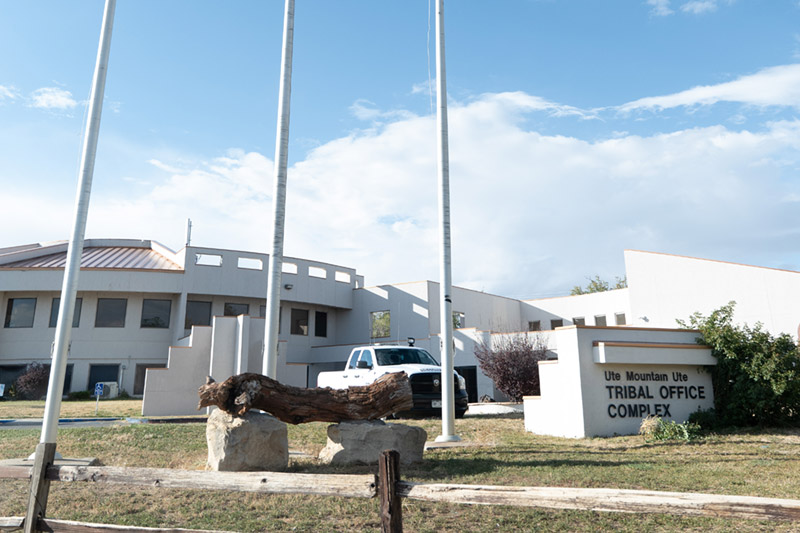
The Ute Mountain Ute tribal office complex in Towaoc, Colo., which has a 24-hour ballot drop box, is shown on Oct. 16, 2024. Photo by Corey Robinson / Special to The Colorado Trust
Baker started his role the month before the 2020 election and had limited resources. Still, the secretary of state’s office touted his efforts as a significant success. According to its data, the 2020 general election turnout increased 24% on the Southern Ute Indian tribal lands and almost 14% among the Ute Mountain Ute compared to 2016.
Baker’s outreach coordinator position existed for less than a month in 2020, concluding right after the election. It has not been announced again.
Colorado has made substantial progress in opening up more voting opportunities—efforts that have continued during this election cycle. Last year, the state passed legislation allowing automatic voter registration for tribal nations, a first in the country. The secretary of state’s office announced in May that a grant of up to $20,000 would be available to both federally recognized tribes to implement programs to increase access to voting.
Colorado also offers language assistance to voters via a multilingual ballot hotline and permits one person to drop off up to 10 mail ballots.
Technically, Native Americans have been enfranchised for 100 years since the federal Indian Citizenship Act was enacted in June 1924. In reality, though, their right to vote fell under state laws. In Colorado, Native Americans living on tribal lands didn’t have guaranteed voting rights until 1970—five years after the passage of the national Voting Rights Act.
Since then, racism and other systemic barriers have continued to affect Native voter turnout. An estimated one-third of eligible Native voters aren’t registered to vote. Many Native people living on reservations do not have typical residential addresses or lack recognized forms of identification, proximity to voter registration centers or internet access to download registration forms. (Colorado does accept tribal membership cards as valid forms of identification.)
Many live long distances from polling places and ballot boxes, and mail delivery—and, thus, voting by mail—remains unreliable in certain areas. Native people have reported hostility when visiting polling places, as the Native American Rights Fund (NARF) has documented. In other states, voter suppression efforts—such as restrictions on same-day registration or submitting ballots on behalf of others—endure.
“It’s just these compounding factors, which are really unique to Native communities and would all add up to putting significant barriers in place,” said Allison Neswood, an attorney with NARF, a nonprofit law firm based in Boulder that works on behalf of Native tribes and people. “Native people, because of the history of mistreatment, are more likely to struggle with poverty or economic insecurity, so that makes all of these barriers much more difficult to overcome.”
As a result, NARF found that nationally, “Native American turnout over the six election cycles averaged 37.2%—a whopping 20.5 percentage points lower than non-Hispanic white turnout,” with the gap widening between 2012 and 2022. In Colorado, U.S. Census data also indicate a racial turnout gap. In 2022, turnout among eligible Black, Hispanic, Asian American and Native voters was 18.7% less than among white non-Hispanic people in the state.
Neither the state nor county election offices track turnout by race or ethnicity. Plus, not every tribal member lives on a reservation, while non-tribal members can live on one, so more specific data beyond what the U.S. Census gathers is impossible to parse. It’s also unclear precisely how the Colorado Secretary of State’s office determined its 2020 turnout statistics, and Secretary of State Jena Griswold declined to comment.
“In Colorado, we have an interesting amount of laws that are attempting to rectify some of these systemic barriers to the Native vote that we don’t see in other states right now,” said Christina Stanton, an associate clinical professor at the University of Colorado Law School where she also serves as director of the American Indian Law Clinic.
In 2019, sweeping voting reforms passed in Colorado, including two changes that impacted Native communities: Tribal councils could request voting centers on tribal lands, and Native residents could use their tribe’s headquarters or other tribe-approved addresses when registering to vote.
La Plata County now has six ballot drop boxes, primarily located in Durango. One is at the Farmers Fresh Market on Ignacio’s main drag, and one is at the library in Bayfield, 10 miles from town.
In 2020, Lee, the county clerk, worked with the tribal council to have a voter service and polling center established at the Southern Ute Cultural Center and Museum. “It’s a great location,” Lee said. “Great parking, great access.”
The site—which also offers voter registration and address change services—was open for four days during the 2022 midterms and will be open again in November.
The Ute Mountain Ute Tribe has similarly seen improved access. A 24-hour drop box is available at tribal headquarters and five other locations across Montezuma County, where the reservation sits. A polling center is open for two days on tribal land, with four other locations within the county. Montezuma County Clerk and Recorder Kim Percell utilizes the tribes’ closed-circuit TV channel to share election information. “Our challenges for delivering ballots is also a countywide discussion,” she wrote in an email.
“We do like to pay attention to Colorado, of course, because tribes are there, but also because we think it helps us push back on the narrative that it isn’t that Native people aren’t interested in voting or don’t want to vote,” Neswood said. “It’s that these barriers are in place, and when strong access is provided, Native people will show up and will make their voices heard and really care about doing that.”
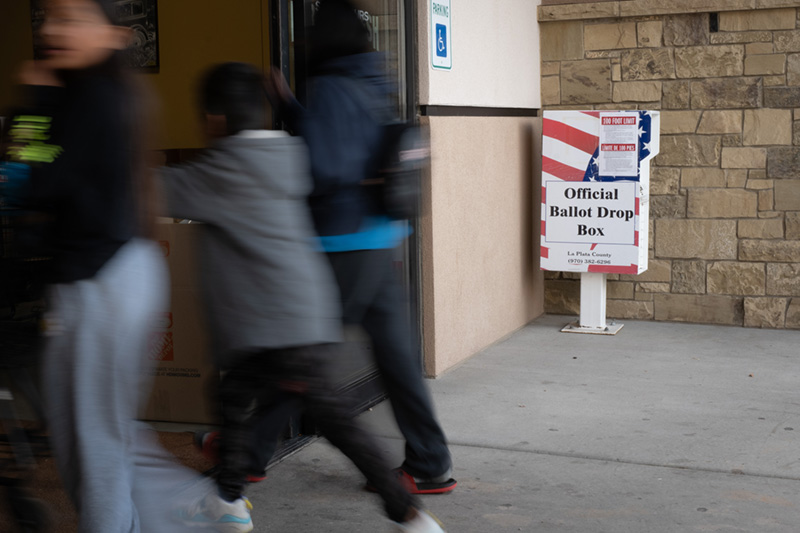
People walk past a ballot drop box on Oct. 18, 2024, outside the Farmers Fresh Market grocery store in Ignacio, Colo. The La Plata County town is home to the Southern Ute Indian Reservation headquarters. Photo by Corey Robinson / Special to The Colorado Trust
Improving voting access is an ongoing effort, and progress can be slow. Recent initiatives such as automatic voter registration for tribal nations—a policy that three other states have since adopted—were crafted with tribal input but have yet to be implemented. Because the program requires tribes to submit member lists to the state government, representatives say it’s unlikely the tribes will participate.
“There’s still just a general distrust of non-Indian governments,” said Peter Ortego, general counsel for the Ute Mountain Ute Tribe. But, he added, tribal members do see that “the State of Colorado is making a genuine effort to try to increase voting for Native Americans generally and the tribal members specifically here in southern Colorado. I think the tribe appreciates those efforts.”
The Southern Ute Indian Tribe has secured over $40 million in grants to expand the reservation’s broadband infrastructure. Once completed in late 2025, high-speed internet will be available to 85% of reservation households and 95% of all tribal member homes. (The Colorado Trust is among the funders for this project.) But Ute Mountain Ute members don’t have broadband access yet. “Information available through the internet would be very, very difficult for some of the tribal members to access,” Ortego said.
“I encourage candidates: Don’t rely on media to inform tribal members about what your positions are, what you’re running for, who you are,” added Ortego. “Meet with the tribe. Arrange to meet with the tribal council. Arrange to have a public meeting or town hall. A lot of those resources that would typically be available in an urban environment are typically not available in rural environments to begin with and even harder on Indian reservations.”
